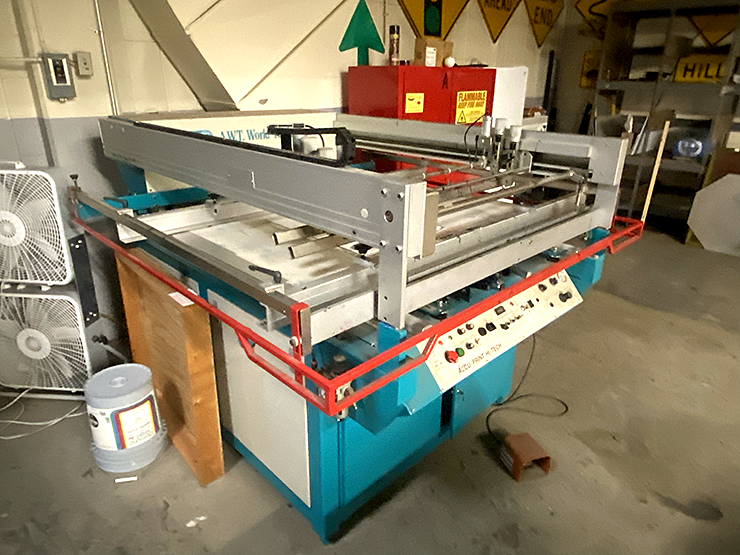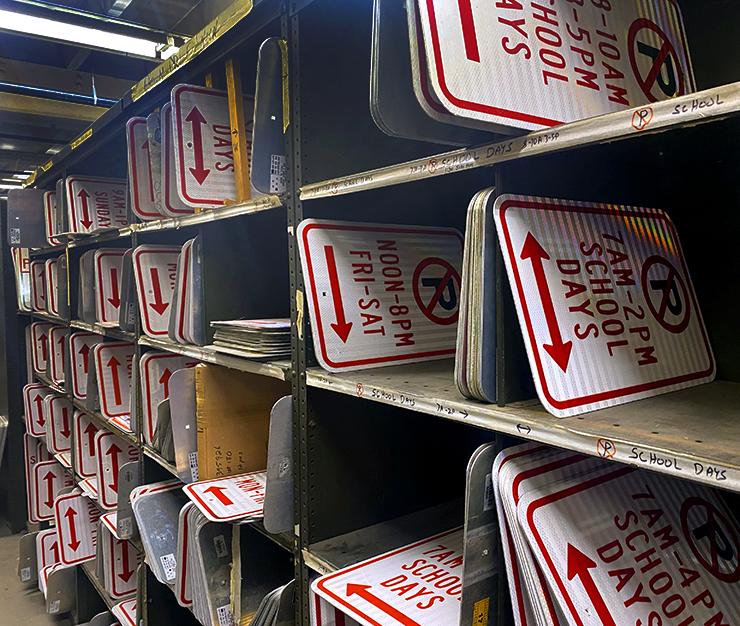The streets and sidewalks in the city of Minneapolis boast over 110,000 street signs, almost all of them are printed, assembled and stored until they’re needed in a shop tucked between the county garbage burner, the Metro Transit bus barn, and the Minneapolis Farmer’s Market.
Given the war of attrition between signs and speeding vehicles, keeping signs on the city’s streets is an endless job, but somebody’s got to do it. Day after day, with humor and dedication, they’re making sure that Minneapolis streets are as well-marked as they can be.
If you’ve never closely looked at a street sign before, you’re not alone. Most people take them for granted and likely never ponder from whence they come. The next opportunity you get, pause for a moment and examine a street sign. You’ll find each one is an elaborately constructed thing: thin metal covered in a 3M reflective layer, overlaid with colorful printed signage and a protective coating on top of that.
The images on each shop sign are manufactured in one of three ways: most often they are screen-printed, sometimes they’re cut from vinyl, and only rarely is a sign printed with ink. (Ink printing is the least durable of the three techniques.)
“That is the ol’ reliable,” said Shane Morton, referring to the ancient-looking screen printing machine against the shop wall.
Morton runs the ten-person Minneapolis sign shop, and as he explains it, he got the job because he’s been here 25 years, learning the art of signage the hard way.
“It can just crank out the signs; in an hour and a half, it can crank out a hundred signs,” Morton said, somewhat reverently, of the screen printer.

Sign-laden cities
Most people don’t think about it, but the vast majority of city signs fall under the category of automobile infrastructure. We need large, visible, and consistent signs not just for overall wayfinding (though they certainly help), but because speeding drivers need to read things quickly, no matter the time of day or night.
The centrality of driving helps explain the visually cluttered landscapes of the American city, which pose a striking contrast to the signage of, say, older cities in Europe or even modern cities in Japan. In those places, signs aimed at people on foot can be far smaller and less intrusive, giving those cities a different aesthetic than a place like Minneapolis.
When you glance at the rows of shelves at the sign shop, containing all 4,000 unique designs used by the city, you realize that most of them are about parking. Because there are so many parking rules, often place and time-specific, these pose a constant headache, and none so much as the time-specific parking signage around schools. With hundreds of schools in the city, and shifting hours of operation, keeping track of which signs go to what corners turns into a Sisyphean task.
“We’ve tried to change some of those out to be kind of consistent,” explained Jennifer Lowry, an engineer who regularly works with the sign shop. “With redistricting, they change what times they want, and you multiply that by all the schools, it can be a headache.”
The larger trend in signage: language is bad, icons are good. Especially given how many languages are spoken in Minneapolis, moving toward a more European style of iconography, and away from tiny indecipherable words, is seen as a sign of progress.

As both Lowry and Morton pointed out, anytime you can simplify things, it’s good for everyone.
Keeping signs up
During the warmer months, the sign shop crew gathers daily in the shop, assembles the day’s signs, and heads out into the field for installation. Maybe one day they’re putting up “9 buttons” (the black, diamond-shaped caution signs); maybe they’re pounding in temporary wooden stakes for paper “No Parking” signs around an event or construction site.
If a crew is installing metal signs, they turn to the “hydro-vac truck” — a machine that shoots water into the roadway to make holes, allowing Public Works staff to drop in a 200-pound pre-cast concrete base. The crew can put up two dozen signs on a good day, which might not sound like much but is a vast improvement from the old hand-dug method. Brute force was required, at considerable risk to the city’s ubiquitous critical underground infrastructure.

Sign o’ the times
Another challenge is removing so-called obsolete signs. Because signs last for decades, and there are so many of them, they can build up and become forgotten. Sometimes, signs outlive their usefulness; for example, the Minnesota Department of Transportation began phasing out those yellow diamond “deer” signs that used to be ubiquitous along the sides of two-lane highways. The logic was that they were so common, nobody noticed them any more, losing any utility they might have once had.
It’s similar with some Minneapolis street signs, like a twenty-year-old “Deaf Child” sign or one pointing out cultural destinations. Life has passed them by, and yet they remain, signaling some forgotten piece of information. One day, someone at the sign shop quietly removes them.
“Wayfinding type-of-signs that we might have done for a church, we’re just getting away from that,” said Shane Morton. “And there are certain signs that haven’t seen as much value, [like] our warning signs.”
Because signs are everywhere all over the city, doing anything takes a long time. A dutiful sign observer can turn a corner and be transported back to a time when signs were different, older, more verbose. Though Minneapolis crews have been systematically replacing old signs for years, with only ten people working on the project, they’re only half done.

0 Commentaires